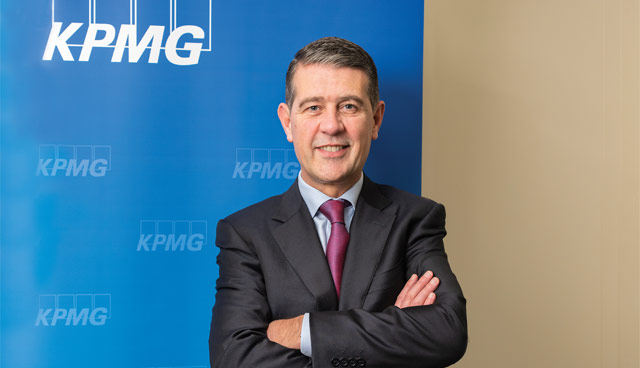Open for disruption


Paul Toner, Partner and Head of Consulting at KPMG, speaks to eolas about approaching the digital transformation challenge in a way that embraces the opportunities of disruption.
Digital disruption is changing the world in which we live and work. New technologies are enabling new business models and changing customer and citizen expectations of service delivery. In this context, successfully redefining what an organisation is and maximising its relevance to the customer and the citizen requires a harnessing of this innovation and disruption.
“From a planning perspective, the days of simply setting long-term goals and moving steadily towards them over many years are gone. Now, it’s necessary to be able to react to uncertainty and respond to change with speed and agility,” Toner says.
However, digital transformation is not merely the preserve of specific sectors, he emphasises. “It’s a key consideration for all sectors. Take the Government’s ‘Our Public Service 2020’ strategy – a key tenet is a focus on increasing ‘delivery for the public’ and digital transformation is at the heart of achieving that.
“The overarching ambition requires an acceleration in the digital delivery of services, an improvement in service levels and an increase in the accessibility of services, while simultaneously driving efficiencies.”
Consequently, both the public sector and the private sector are challenged in this ambition. A recent survey undertaken by KPMG reveals that a key strategic priority for CEOs is digitising their business. At the same time, over 50 per cent were concerned that their organisations do not have the sensory capabilities and innovative processes to respond to rapid disruption. “In other words, there is a mismatch between the aspiration to ‘go digital’ and the capability to do so in a strategically coherent way,” Toner explains.
“The most important thing to be cognisant of is that digital transformation should be addressed on an incremental basis, allowing for continuous and effective evolution.”
The opportunities are immense and for many organisations it can be overwhelming. “Only those that understand how far and fast they need to transform will be successful,” he argues. “Before I talk about how we advise our clients in striving for success, let me say that the most important thing to be cognisant of is that digital transformation should be addressed on an incremental basis, allowing for continuous and effective evolution.
“It’s not a one-time thing. To use a favourite expression of consultants, it’s a journey – and not simply a technology one – but one that requires constant commitment. Failure to recognise this will result in some success in the near term but then, having raised expectations, you will create customer and citizen frustrations which are likely to increase your costs and inefficiencies by having to support multiple business models,” Toner suggests.
KPMG, he details, has identified four steps to guide clients successfully through their digital transformation journeys. These are: understanding sector specific opportunities; creating a business strategy from the outside-in; articulating an operational strategy that connects the front, middle and back office; and embedding culture change programmes.
Sector specific
The impact of digital disruption varies across different sectors. As such, while consistently creating unprecedented opportunities to adopt alternative business models, each sector is unique in the approach it requires.
“All organisations can leverage digital innovations such as mobility, robotics and intelligent systems. What matters is how you bring them together to address specific business and organisational challenges.
“Harnessing the power of multiple disruptors provides an organisation with the opportunity to transform and thrive by creating new pathways to value. These might be new business models, new offerings or new services,” the KPMG partner explains.
One example of an innovative approach to healthcare in the UK, he highlights, is the NHS Choices service. The service aims to put consumers in charge of their healthcare and includes a comprehensive information and service directory and ability to transact online with healthcare providers in processes which include: booking appointments; requesting referrals; and comparing waiting times.
“Today it attracts 25 per cent of all healthcare traffic in the UK. It’s a really good example of an organisation fundamentally challenging themselves to be innovative,” he remarks.
Outside-in strategy
Toner maintains that true digital transformation begins with the customer or the citizen and works inwards, connecting capabilities to ensure that every component of the organisation is built around delivering against expectations. In other words, it’s necessary to clearly delineate the customer journeys that are being created, ensuring that they can achieve their intended outcome.

“Encouraging innovative thinking at all levels empowers people to take risks. This means embracing experimentation and championing inventive ideas.”
“In the public sector, the citizen is required to engage with multiple facets of the State for service and frequently needs to navigate across a number of areas to complete a full end-to-end transaction. As a result, many governments are introducing digital identities for every citizen.
“In this regard, Ireland is making good progress. The launch of the MyGovID in 2017 was a huge step and I know the Office of the Government Chief Information Officer is focused on the strategic need for increasing the adoption and usage,” asserts Toner.
Connecting the front, middle and back office
In its recent CEO survey, KPMG found that over 52 per cent of organisations said they had aligned middle and back office processes to reflect a more customer centric approach to front office operations. Realising full value is much more than building customer-facing digital platforms, indicates the Consulting Head.
“You need to go all the way to the back – through distribution, billing and business services – taking an enterprise-wide approach. This results in what IDC refers to as ‘customer intimacy at scale’.
“Meeting the universal expectation of a customised citizen grade experience across all transactions requires overhauling both the digital front office and the operational middle and back offices. Improving transparency and connectivity in the supply chain is integral to a seamless customer or citizen experience,” he outlines.
The effective and highly responsive use of individual data is absolutely critical to the delivery of the personalised service demanded by customers and citizens. In the front office, understanding the needs of the citizen is essential. This entails a willingness to change services and business models that do not contribute to a better experience.
Simultaneously, in the middle office, the focus needs to be on removing friction in the process, reducing the likelihood of slowdowns or the need for manual interventions. “Get it right and you can strengthen service level commitments and provide visibility into events that require a real-time response,” says Toner.
At the same time, in the back office, the focus is on driving down costs. Increasing automation through technologies such as robotics and adding intelligent systems can release the human workforce to complete expert, added-value tasks and for decision-making.
“In Ireland, we have a world class example in Revenue Online Service, which transformed a highly paper-based, manual process, into a true digital service that continues to innovate to meet citizen expectations.
“While the front end is the enabler, the real achievement is the extent to which Revenue have succeeded in addressing the middle and back office activities, resulting in end-to-end processing services. Furthermore, it is a tremendous example of how a true digital service can enable the collection of data to drive the overall effectiveness of the tax collection process,” he affirms.
Cultural change programmes
By its nature, digital requires operating model change. Just as digital disruption is industry specific, Toner maintains, cultural change is contextual; meaning there is no one-size-model to fit all scenarios. For instance, market hype on the impact of automation on jobs can create fear and uncertainty affecting buy-in and commitment to participate in innovation.
“Successful cultural change depends on having a clear unified vision, and on engaging and inspiring staff. In my experience, a succession of quick wins is one of the most effective way of achieving the required buy-in and support.
“However, of all the interventions that move culture in the right direction, the most important is leadership,” he says, adding: “It might be surprising to learn that the vast majority of digital transformation programmes fail to achieve targeted outcomes because of a lack of leadership.
“Encouraging innovative thinking at all levels empowers people to take risks. This means embracing experimentation and championing inventive ideas. In such an environment, digital disruption is not a threat but an opportunity to create smarter offerings and services.”
A final area that Toner identifies as being a frequently underestimated challenge is the process of migrating the citizen towards embracing these new service models. “There are lots of examples – many in banking – where digital adoption was a key feature of trying to deal with cost pressures of the financial crisis.
“Customers were aggressively pushed towards new digital channels only to find they were not ready, even if the banks in question were. The outcome was a damaged relationship and increased cost from having to maintain both new and legacy delivery channels.”
“Tackling digital transformation with a siloed view or with a technology-first focus will not work.”
Conclusion
Overall, approaching the uncertainties around digital transformation with confidence means understanding that this is not a single once-off change. Instead, Toner reiterates, it must be regarded as a continuous journey. This means a collection of decisive actions which, when combined, move an organisation forward to achieve its vision.
“Tackling digital transformation with a siloed view or with a technology-first focus will not work,” he warns. “Instead of engaging in a series of digital experiments, organisations need to redefine their business transformation to be a digital transformation. Taking account of the full range of challenges and the specific mix of disruptors that can impact them, organisations must set forth a vision and a strategy for the entire organisation.
“Cultural change must be a key consideration alongside the role of data and analytics in informing all transformative decisions. From this position, it becomes possible to create a fully connected organisation that delivers value efficiently – all with an unwavering eye on the customer and the citizen,” Toner concludes.
Dublin native Paul Toner heads the Consulting practice at KPMG. In a 30-year career beginning at IBM, Paul has worked in the UK, Europe and the US and for a period, across the EMEA region as the lead of the public sector in a consulting firm.
Throughout a career that began in technology, Paul has specialised in consulting for the past 20 years and is focused on helping clients to transform their organisations. In 2008, he returned to KPMG in order to re-establish Management Consulting following divestment in consulting practices across ‘the big four’ in the early 2000s. Since then, KPMG has grown to be a leading consulting firm in the Irish market with a team of over 400 local specialists.
A keen Dublin GAA fan, Paul is married with three adult children.





